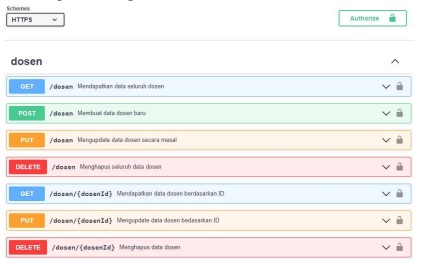Identifikasi Kandidat Microservices Dengan Analisis Domain Driven Design
Abstract
This study aims to identify microservices in sistem informasi dosen (SIMDOSEN) of udayana university using Domain Driven Design analysis. SIMDOSEN was developed with a monolithic architecture and has several modules including lecturer data management module, lecturer history, management of tridharma perguruan tinggi activities, lecturer performance targets, etc. Dynamic policy changes cause the system to be difficult to adapt to accommodate needs and lack of documentation cause different interpretations of system function between programmers. With microservices, the system will be split into several services using a RESTful API which is documented using OpenAPI Specifications so that it is hoped that the development of SIMDOSEN will be more adaptive to changes in system requirements and reduce misunderstanding between programmers in the future.
Downloads
References
[2] Martin Fowler (2014) DomainDrivenDesign. [Online]. Available: https://martinfowler.com/bliki/DomainDrivenDesign.html
[3] Martin Fowler (2014) BoundedContext. [Online]. Available: https://martinfowler.com/bliki/BoundedContext.html
[4] Evans, Eric, Domain-driven design: tackling complexity in the heart of software, Addison-Wesley, 2004.
[5] C. Y. Fan, S. P. Ma, “Migrating Monolithic Mobile Application to Microservice Architecture: An Experiment Report,” IEEE 6th International Conference on AI and Mobile Services, p. 109–112, 2017.
[6] N. Dragoni, S. Giallorenzo, A. L. Lafuente, M. Mazzara, F. Montesi, R. Mustan, L. Sana, “Microservices: yesterday, today, and tomorrow”, Present and Ulterior Software Engineering, pp 195-216, 2017.
[7] (2021) OpenAPI Specification. [Online]. Available: https://swagger.io/specification/
[8] S. Newman, Building Microservices: Designing Fine-Grained Systems. 1st ed. O'Reilly Media, 2015.
[9] I. W. Len Bass and L. Zhu, DevOps: A Software Architect’s Perspective. Addison-Wesley Professional, 2015.
[10] V. Vaugh, Implementing Domain-Driven Design, Addison-Wesley Professional, 2013.
[11] R. Fielding, J. Gettys, J. Mogul, H. Frystyk, L. Masinter, P. Leach, and T. Berners-Lee. Hypertext Transfer Protocol – HTTP/1.1. Technical Report RFC 2616, The Internet Society, http://www.ietf.org/rfc/rfc2616.txt, 1999.
[12] R. Fielding. Architectural Styles and the Design of Network-based Software Architectures. Ph.d. dissertation, University of California, Irvine, 2007.
[13] C. Pautasso. Restful web services: principles, patterns, emerging technologies. In Web Services Foundations, pages 31–51. Springer, 2014.
[14] D. Jacobson, G. Brail, D. Woods, APIs: A Strategy Guide. O’Reilly Media, Inc., 2011.
[15] M. Gebhart, P. Giessler, S. Abeck, “Challenges of the Digital Transformation in Software Engineering,” ICSEA 2016: The Eleventh International Conference on Software Engineering Advances, 2016, pp. 136–141.
[16] D. M. Rathod, S. M. Parikh, B. V. Buddhadev, “Structural and Behavioral Modeling of RESTful Web Service Interface Using UML,” International Conference on Intelligent Systems and Signal Processing (ISSP), March 2013, pp. 28–33.
[17] P. Giessler, M. Gebhart, D. Sarancin, R. Steinegger, S. Abeck, “Best Practices for the Design of RESTful Web Services,” International Conferences of Software Advances (ICSEA), 2015.
[18] B. Hippchen, P. Giessler, R. Steinegger, M. Schneider, S. Abeck, “Designing Microservice-Based Applications by Using a Domain Driven Design Approach,” International Journal on Advances in Software, Vol. 10, No. 3&4, pp. 432–445, 2017.
[19] A. Sill, "The Design and Architecture of Microservices,” IEEE Cloud Computing, vol. 3, no. 5, pp. 76-80, 2016.
[20] B. Butzin, F. Golatowski and D. Timmermann, "Microservices approach for the internet of things," IEEE 21st International Conference on Emerging Technologies and Factory Automation (ETFA), pp. 1-6, 2016.
[21] S. Karlsson, A. Čaušević and D. Sundmark, "QuickREST: Property-based Test Generation of OpenAPI-Described RESTful APIs," IEEE 13th International Conference on Software Testing, Validation and Verification (ICST), pp. 131-141, 2020.
[22] J. Kazanavičius and D. Mažeika, "Migrating Legacy Software to Microservices Architecture," 2019 Open Conference of Electrical, Electronic and Information Sciences (eStream), pp. 1-5, 2019.
[23] S. Baškarada, V. Nguyen, A. Koronios. “Architecting Microservices: Practical Opportunities and Challenges.” Journal of Computer Information Systems, pp. 1–9, 2018
[24] R. Chen, S. Li and Z. Li, "From Monolith to Microservices: A Dataflow-Driven Approach," 24th Asia-Pacific Software Engineering Conference (APSEC), pp. 466-475, 2017.
[25] P. D. Francesco, I. Malavolta and P. Lago, "Research on Architecting Microservices: Trends, Focus, and Potential for Industrial Adoption," IEEE International Conference on Software Architecture (ICSA), pp. 21-30, 2017.
[26] Y. Gan and C. Delimitrou, "The Architectural Implications of Cloud Microservices," IEEE Computer Architecture Letters, vol. 17, no. 2, pp. 155-158, 2018.
[27] K. Kurniawan, N. Putra Sastra, and M. Sudarma, “Analisis Performansi Dan Efisiensi Cloud Computing Pada Sistem Perbankan”, Majalah Ilmiah Teknologi Elektro, vol 19, no 1, pp 11-18, Oct. 2020.


This work is licensed under a Creative Commons Attribution-NonCommercial-NoDerivatives 4.0 International License.

This work is licensed under a Creative Commons Attribution 4.0 International License




